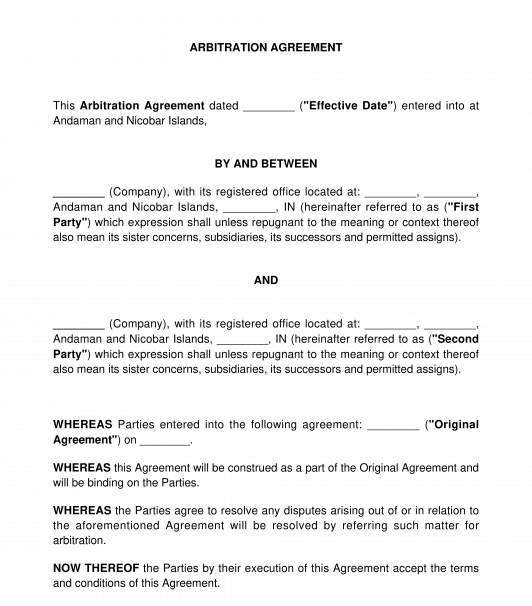 25-09-2025
25-09-2025

Answer a few questions and your document is created automatically.

Your document is ready! You will receive it in Word and PDF formats. You will be able to modify it.

 25-09-2025
25-09-2025
 Word and PDF
Word and PDF
 6 to 10 pages
6 to 10 pages
This Arbitration Agreement is a legally binding contract between two parties as an alternative method to resolve the disputes between them. Civil disputes unless explicitly barred under the applicable laws between two parties can be resolved through arbitration (the process of resolving the dispute by appointing a neutral third party as arbitrator).
Nowadays, with complicated commercial disputes and an increased burden on courts, arbitration is a sought-after method to resolve issues without resorting to the court system.
The parties entering into a contract or business relation can also agree to resolve any dispute by way of mediation before resorting to arbitration. Under mediation, the settlement is between the parties without involving any third party as an arbitrator. Mediation will be less formal than arbitration as parties after discussion settle on a middle ground where they can settle the dispute. Thus, to maintain a long-term good relationship between the parties, the mediation method can be used to resolve the dispute before going to arbitration.
The arbitration can be either institutional or ad-hoc. Under institutional arbitration, the recognized institution will be setting the rules of arbitration and appointing appropriate arbitrators considering the dispute. The main benefit of ad-hoc arbitration is the availability of qualified arbitrators and pre-set rules.
On the other hand, under ad-hoc arbitration, the Parties appoint the Arbitrator from time to time and set their own rules to resolve the Dispute. The main benefit of ad-hoc arbitration is flexibility and reduced cost in comparison to institutional arbitration.
There is no predetermined qualification to be appointed as an arbitrator in India. Even a foreign national can be an arbitrator.
To be enforceable under the law, the arbitration agreement must be in writing and shall be properly stamped. Once agreed in writing for arbitration, the parties cannot directly approach the court before completing the arbitration procedure.
Arbitration agreements are often signed at the beginning of the business relationship. However, the parties can enter into an arbitration agreement later by making the same binding on the master agreement or business transaction.
Advantages of arbitration
This arbitration agreement can be used for any type of entity including a company, LLP, Partnership, NGO, etc. for resolving issues/disputes not excluded under the applicable law. Some matters cannot be resolved through arbitration including the following:
How to use this Agreement?
This Agreement covers the following major areas:
The Arbitration Agreement should be printed on non-judicial stamp paper and then both the Parties will need to sign the document and keep a copy for their records.
This Agreement can also be Notarized by a public notary for more authenticity and recording of the date and time of the execution of the Agreement.
Applicable laws
The laws of The Limitation Act, 1963 applicable to civil laws also applies to arbitration.
The arbitration with the seat of arbitration in India will be governed under The Arbitration and Conciliation Act, 1996.
How to modify the template?
You fill out a form. The document is created before your eyes as you respond to the questions.
At the end, you receive it in Word and PDF formats. You can modify it and reuse it.
A guide to help you: What to do after Finishing a Contract?
Arbitration Agreement - Sample, template - Word and PDF
Country: India